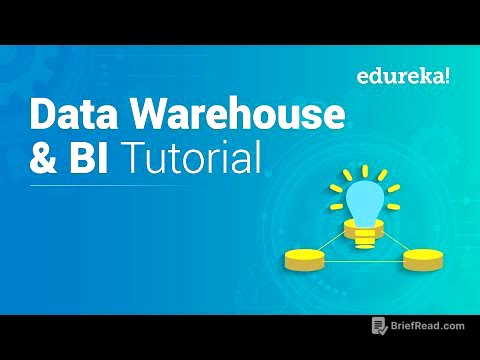TLDR;
Alright, so this webinar by Alex the Analyst is all about SQL, taking you from a complete beginner to someone who knows their way around advanced concepts. He talks about what SQL is, how it's used, and why it's super important for data analysis. Plus, he shares some real-world examples and tips for optimizing your queries. Key takeaways include:
- SQL is a must-know skill for data analysts, more valuable than Excel or other tools.
- Filtering, sorting, grouping, and aggregating data are fundamental SQL skills.
- Joins and subqueries are essential for combining data from multiple tables.
- Optimizing SQL queries and automating tasks can significantly improve efficiency.
Intro to SQL and Databases [0:00]
William from Career Foundry introduces Alex Freeberg of Alex the Analyst YouTube channel, welcoming his fans. The webinar aims to cover SQL from beginner to advanced levels in one hour. Career Foundry is an online school that helps people transition into tech careers, particularly data analytics, with flexible programs, mentorship, and a job guarantee. William then hands over to Alex, who expresses his enthusiasm for SQL, considering it a core skill in his tech stack.
SQL Basics: Databases, Tables, and DQL, DDL, DML [3:30]
Alex starts with the basics, defining SQL as a query language used to interact with data stored in SQL databases. While some consider it a programming language, it's primarily a standard way to retrieve and manipulate data in both static and dynamic databases, including web development and data analysis. He explains that a database is a collection of tables and views, storing data in one central place. Tables are like Excel spreadsheets with columns and rows of data. Alex also touches on DQL (Data Query Language), DDL (Data Definition Language), and DML (Data Manipulation Language), explaining their roles in selecting, defining, and manipulating data within a database.
Filtering and Sorting Data [8:04]
Filtering and sorting data are very important for data analysts. Filtering allows you to specify exactly what data you want to pull from a large dataset, selecting specific columns and rows based on certain conditions. Sorting arranges the data in a specific order, making it easier to visualize and analyze. Alex provides an example using a "Bakery employees" table, demonstrating how to filter data based on salary and department using the WHERE clause. He also shows how to sort data by department in ascending order using the ORDER BY clause.
Grouping and Aggregating Data [11:27]
Grouping data combines similar values in a column, allowing you to perform aggregate functions like SUM, AVERAGE, and MEDIAN. This is useful for creating reports and statistical analysis, especially with large datasets. Alex uses the "employees" table to demonstrate grouping by department and calculating the average salary for each department. He highlights the importance of grouping and aggregating data for gaining insights from large datasets.
Joins and Subqueries [14:47]
Joins combine rows from two or more tables based on related columns, allowing you to work with data spread across multiple tables. Alex explains different types of joins: inner joins (overlapping data), left joins (all from the left table, matching from the right), and right joins (all from the right table, matching from the left). Subqueries are queries within queries, allowing you to utilize other tables. Alex notes that joins are generally faster than subqueries, especially with large datasets. He provides examples of both joins and subqueries, explaining the syntax and use cases.
Window Functions [23:19]
Window functions perform calculations and aggregations over a subset of data without grouping the results into a single row. This allows you to calculate running totals, rankings, and moving averages while retaining the original row-level data. Alex explains the difference between GROUP BY and window functions, noting that window functions are more advanced and have specific use cases. He demonstrates ranking functions like RANK, DENSE_RANK, and ROW_NUMBER, showing how they can be used to rank employees based on salary.
Optimizing SQL Queries [28:30]
Optimizing SQL queries improves the efficiency and speed of query execution, which is crucial when working with large datasets. Techniques include indexing, rewriting queries, and proper data modeling. Indexing involves telling SQL to remember specific columns for faster retrieval. Alex provides examples of indexing and rewriting queries for faster execution. He also mentions the EXPLAIN command, which analyzes a query's performance.
Automation in SQL [37:46]
Automation in SQL involves using scripts, stored procedures, and schedulers to automate repetitive tasks like data ingestion, data cleaning, and report creation. Alex provides an example of automating nightly backups of a database. He also discusses real-world examples of SQL use, including managing inventory, tracking sales, analyzing customer data, and web applications.
Real-World Examples and the Importance of SQL [40:45]
Alex shares real-world examples of SQL use, such as managing inventory, tracking sales, analyzing customer data, and web applications. He emphasizes that SQL is a crucial skill for data analysts, more valuable than Excel or other tools. He highlights its transferability to cloud platforms like Azure and AWS. Alex encourages viewers to learn SQL, emphasizing its importance in their careers.
Q&A: Skills, Soft Skills, and Getting Experience [45:01]
William from Career Foundry hosts a Q&A session with Alex. They discuss essential programming languages for junior data analysts, emphasizing SQL and Excel. Alex highlights the importance of soft skills, such as communication and teamwork, in addition to hard skills. They also discuss how to gain practical experience through projects, volunteering, and freelancing.
Challenges and Tips for Beginners [56:52]
Alex discusses common challenges for beginners in data analytics, such as feeling overwhelmed and encountering experienced SQL users. He shares tips for overcoming imposter syndrome, such as studying and connecting with mentors. They also discuss the importance of statistics and math in data analytics, with Alex suggesting that basic knowledge is sufficient for most data analyst roles.
Staying Up-to-Date and Building a Portfolio [1:03:32]
Alex shares resources for staying up-to-date with industry trends, including community forums, Twitter, LinkedIn, and Medium. He emphasizes the importance of having a good community for sharing information. They also discuss the value of having a portfolio of work, with Alex recommending it as a way to improve your chances of getting interviews and jobs. William concludes the webinar, thanking Alex and the audience for their participation.









